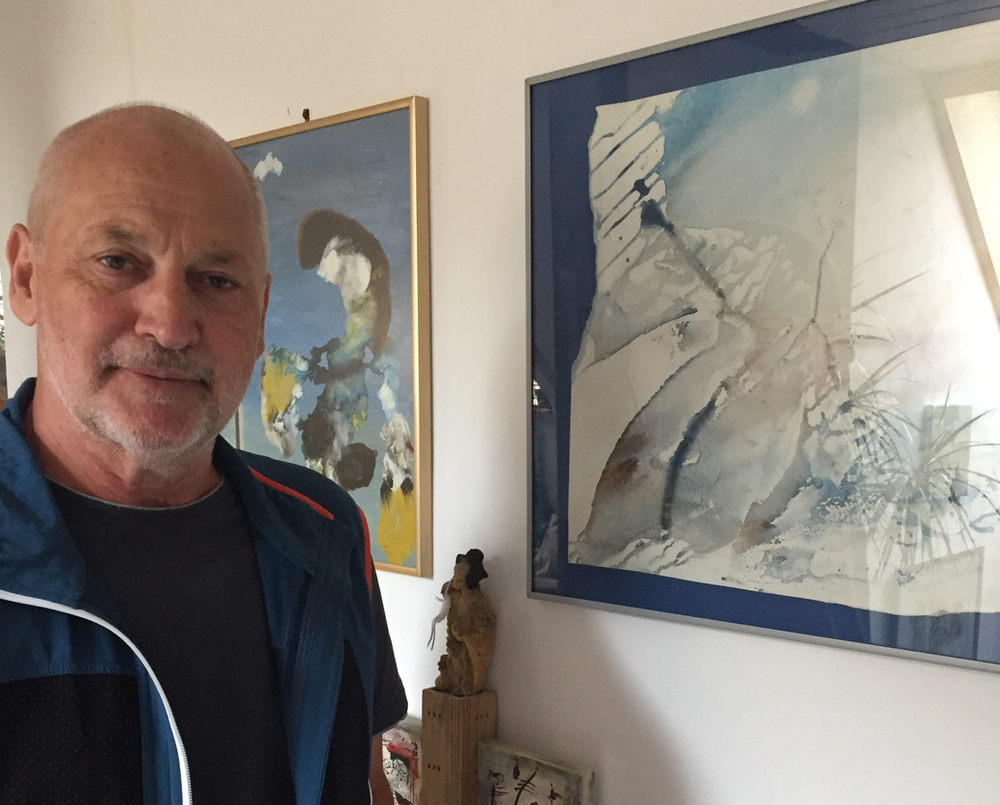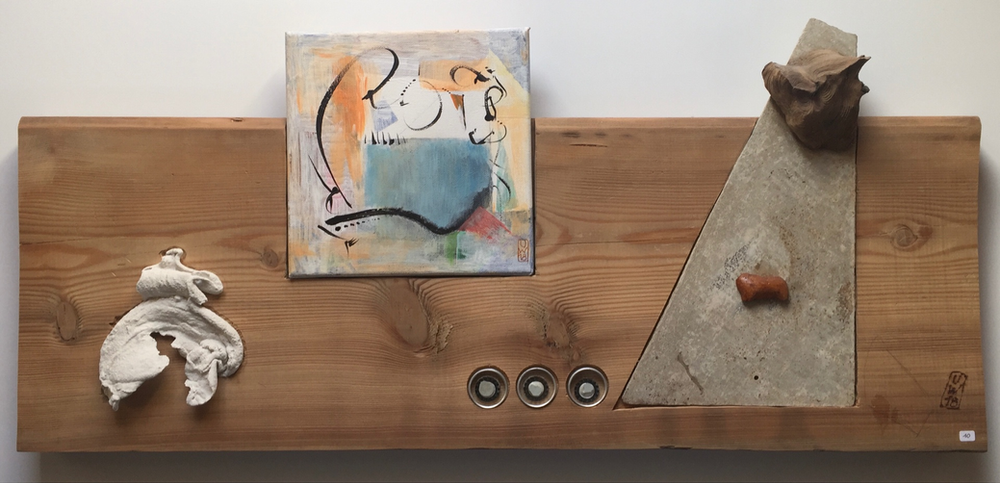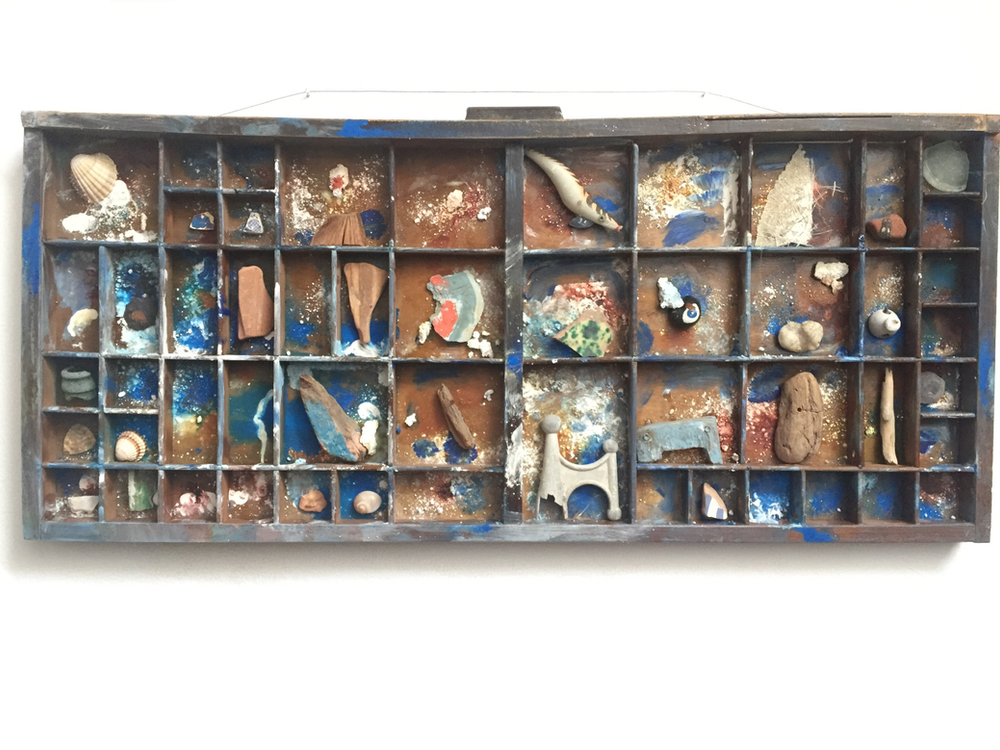
Ulrich Wallner
Quando l’intuito creativo si manifesta è impossibile trattenerlo o resistergli, e nel caso di Ulrich Wallner l’impulso ad avvicinarsi al percorso artistico è avvenuto negli anni giovanili, quelli in cui si gettano le basi per il futuro; appena diplomato si iscrive a un corso per corrispondenza e quello è il momento in cui decide che l’arte sarà la sua strada, quella che poi avrebbe segnato e contraddistinto tutta la sua vita. Segue gli studi pedagogici per diventare insegnante di arte visiva presso la scuola dell’obbligo e quel percorso accademico gli permette di misurarsi e sperimentare molte tecniche pittoriche scegliendo quella a cui si sente più affine in quella fase. Inizia dunque avvicinandosi alla figurazione salvo poi sentire l’esigenza interiore di approfondire la manifestazione emozionale in maniera meno controllata, più istintiva, orientandosi sempre di più verso la non forma, verso un Espressionismo Astratto da cui si sente affascinato proprio in virtù della spontaneità esecutiva e la mancanza di ogni tipo di regola esecutiva. La sperimentazione per Ulrich Wallner sembra essere sinonimo stesso di fare arte, così come la modificazione dello stile è innato nella sua natura orientata all’evoluzione e al confronto con se stesso e con la propria modalità comunicativa così, dopo tanti anni in cui la sua produzione artistica è limitata dal ruolo di dirigente scolastico, scopre il fascino dell’Informale Materico, quell’approccio più ragionato e meditato sull’utilizzo di oggetti in sinergia con i colori e con la tela prendendo ispirazione anche dalle tematiche del Dadaismo per dare origine a un linguaggio del tutto personale. Laddove i dadaisti infatti sono ironici e spesso dissacranti sulla società, sull’arte, su tutto ciò che era ed è convinzione comune, regola acquisita che deve essere scardinata o sarcasticamente attaccata, Ulrich Wallner elabora uno stile in cui, pur evidenziando tematiche esistenziali, non emerge mai la polemica pungente o l’attitudine a rompere gli schemi bensì il desiderio di portare alla luce pensieri, emozioni e sensazioni propri che non possono fare a meno di far riflettere anche l’osservatore su se stesso e sulla realtà contemporanea. L’inclinazione al riutilizzo si sposa con il pensiero ambientalista a cui l’artista è particolarmente sensibile sia dal punto di vista più strettamente ecologico sia da quello filosofico poiché la società attuale tende inevitabilmente al consumo rapido, alla non conservazione di ciò che è stato utilizzato per poco tempo perché l’interesse si sposta velocemente verso il successivo oggetto del desiderio, oppure semplicemente verso l’acquisto di altro che induce a far passare in secondo piano il precedente. Nell’opera Erinnerungen einer Kellertreppe (Ricordi di una scala nella cantina)

Erinnerungen einer Kellertreppe
Ulrich Wallner utilizza frammenti di materiale povero, quelli persi a volte negli spazi inutilizzati delle case e completamente dimenticati, per evocare un mondo semplice, forse legato alla sua infanzia, sottolineando quanto ciò che sembra non avere più senso possa invece assumerlo se guardato con altri occhi; medesimo approccio è quello di Maritime Erinnerung (Ricordi marittimi),

Maritime Erinnerung
in cui è il mare a essere protagonista, con tutti gli elementi che lo contraddistinguono, conchiglie, sassi, frammenti di oggetti perduti dall’uomo ed erosi dall’acqua, un mondo che profuma di ricordi, di corse sul bagnasciuga, di memoria di attimi sereni e rilassati. Argilla, vetro, legno, sono i materiali utilizzati da Ulrich Wallner per manifestare il suo pensiero e le sue emozioni sulla vita e sul mondo contemporaneo. Andiamo ora ad approfondire con l’artista le tematiche e il suo particolare linguaggio pittorico.
L’insegnante era il teorico che cercava di trasmettere le proprie conoscenze e competenze agli studenti nel miglior modo possibile. L’artista era l’operatore che poteva sostenere gli studenti nell’applicare e testare la conoscenza e quindi promuovere l’abilità. Insegnavo ciò che avevo imparato io stesso, quindi in questo senso l’insegnamento ha influenzato il percorso creativo. La mia attività artistica mi ha permesso di trasmettere le mie conoscenze in modo più mirato riuscendo così a risparmiare ai miei studenti i miei stessi sbagli. Ma se ritenevo che fosse importante per loro fare certe esperienze, li lasciavo camminare con le proprie gambe anche se sapevo che li avrebbe portati a commettere errori. Era particolarmente importante per me mostrare un alto grado di tolleranza, di accoglienza verso tutti gli artisti e questo è sempre stato molto difficile nella nostra zona rurale, soprattutto per quanto riguarda l’arte contemporanea.
Ulrich, lei ha dedicato l’intera vita all’arte, come è stato essere al tempo stesso insegnante e artista? Quanto ciò che insegnava ha influenzato il suo percorso creativo o quanto, al contrario, è stato il suo modo di intendere l’arte a influenzare il metodo di insegnamento?
L’insegnante era il teorico che cercava di trasmettere le proprie conoscenze e competenze agli studenti nel miglior modo possibile. L’artista era l’operatore che poteva sostenere gli studenti nell’applicare e testare la conoscenza e quindi promuovere l’abilità. Insegnavo ciò che avevo imparato io stesso, quindi in questo senso l’insegnamento ha influenzato il percorso creativo. La mia attività artistica mi ha permesso di trasmettere le mie conoscenze in modo più mirato riuscendo così a risparmiare ai miei studenti i miei stessi sbagli. Ma se ritenevo che fosse importante per loro fare certe esperienze, li lasciavo camminare con le proprie gambe anche se sapevo che li avrebbe portati a commettere errori. Era particolarmente importante per me mostrare un alto grado di tolleranza, di accoglienza verso tutti gli artisti e questo è sempre stato molto difficile nella nostra zona rurale, soprattutto per quanto riguarda l’arte contemporanea.

Schwarze Wolke am Horizont (Nuvole nere all’orizzonte)
La libertà espressiva ha costituito uno dei punti cardine della sua ricerca: quanto è importante far comprendere ai giovani l’importanza di un cammino individuale che spesso deve distaccarsi dalle regole accademiche necessarie solo come base di conoscenza?
La ricerca e la sperimentazione sono sempre state la base per la creazione di qualcosa di nuovo. Questo vale sia per la scienza e la tecnologia che per tutti i tipi di arte. Nel caso della letteratura, della musica e delle arti visive tuttavia, la libertà in qualsiasi forma è di particolare importanza. Un’educazione di successo funziona solo attraverso un’interazione tra apprendimento e rispetto delle regole e libertà e tolleranza. Ho sempre incoraggiato i miei studenti a cercare soluzioni individuali per trovare il loro percorso personale. Ciò implica il mettere costantemente in discussione un insieme di regole esistenti e – se necessario – di non seguirle, tenendo conto delle conseguenze.
Vorrei approfondire il tema dell’effimero, della mancanza di tendenza alla conservazione degli oggetti, e spesso anche degli affetti, della società contemporanea, tema che emerge dalle sue opere materiche. Ci spiega meglio il suo punto di vista in merito?
Il ritmo veloce del nostro tempo è già evidente nella produzione di oggetti di breve durata. Il consumo rapido è più importante della sostenibilità, buttare via le cose viene prima di conservare e riparare. Mi interessano le tracce d’uso e i danni agli oggetti che raccontano la loro storia. Non mi piace gettare niente, al contrario vorrei dare a tutte le cose inutili e scartate una nuova ragion d’essere rielaborandole, combinandole e riproponendole. Raccolgo i miei oggetti trovati nei mercati delle pulci, sulle spiagge e nella natura. Il tema ha un significato speciale quando si tratta di esseri viventi. Mi intristisce osservare con quanta facilità e rapidità si concludono e si gettano via le relazioni oggi, sia con le persone che con gli animali; anche in questo caso, “riparare” sembra essere diventato via via meno importante.

Symbiotische Beziehung (Relazione simbiotica)
Quali sono gli artisti del passato e del presente a cui si è ispirato nel suo lungo percorso artistico?
Durante il mio periodo di formazione, erano soprattutto gli artisti del passato a essere importanti I vecchi maestri erano essenziali fonti di conoscenza sulle tecniche, la composizione, l’uso dei colori… Il mio interesse iniziò con gli impressionisti e gli espressionisti. Sono stato particolarmente colpito da Henri de Toulouse-Lautrec ed Egon Schiele, il che mi ha portato a fare viaggi ad Albi e Krumau. A Berlino ho potuto poi conoscere l’opera di Joseph Beuys, che per me è stato un significativo ampliamento del mio concetto di arte. Nel mio lavoro sono stato fortemente influenzato da Max Ernst. Tecniche come il collage, il frottage e la decalcomania mi affascinavano particolarmente. Attraverso il mio coinvolgimento con il Dadaismo, ho conosciuto Kurt Schwitters, Nancy e Edward Kienholz e Daniel Spoerri, e con loro l’assemblaggio, che ancora oggi mi ispira. Naturalmente, sono anche interessato a ciò che fanno gli artisti contemporanei, specialmente quelli che si occupano di sperimentazione e metodi di lavoro intuitivi.

Ballerina
Ha appena partecipato alla mostra collettiva internazionale Vienna Art Summer, quali sono i suoi prossimi progetti?
Da un lato, continuerò a lavorare con l’inclusione della plastica lavorata nei miei assemblaggi e a espandere la mia esperienza. Anche l’uso di oggetti trovati e la loro trasformazione rimarrà un tema basilare della produzione artistica che ormai mi contraddistingue. Nel disegno e nella pittura, tuttavia, mi dedicherò di nuovo più alla figurazione. A luglio, ho frequentato un corso di nudo con l’artista Renate Moran e, oltre ad acquisire molte nuove conoscenze mi sono sentito anche molto ispirato a proseguire su questo nuovo percorso. Se avrò l’opportunità di esporre il mio lavoro, l’accetterò volentieri.
ULRICH WALLNER-CONTACTS
Email: ulwa1112@gmail.com
Facebook: https://www.facebook.com/ulrich.wallner
Instagram: https://www.instagram.com/wallnerulli/
Marta Lock’s interviews:
Ulrich Wallner, a life dedicated to art
When creative intuition manifests itself, it is impossible to hold it back or resist it, and in Ulrich Wallner’s case the impulse to approach the artistic path occurred in his youth, when the foundations for the future were being laid; as soon as he graduated he enrolled in a correspondence course and that was the moment when he decided that art would be his path, the one that would later mark and distinguish his entire life. He followed his pedagogical studies to become a teacher of visual art at the compulsory school, and this academic path allowed him to measure himself and experiment with many painting techniques, choosing the one he felt most like at that stage. He began by approaching figuration, but then felt the inner need to deepen the emotional manifestation in a less controlled, more instinctive way, moving more and more towards non-form, towards an Abstract Expressionism from which he felt fascinated by the spontaneity of execution and the lack of any kind of executive rule. For Ulrich Wallner, experimentation seems to be synonymous with making art, just as the modification of style is innate in his nature, oriented towards evolution and confrontation with himself and his own mode of communication. Thus, after many years in which his artistic production was limited by his role as school director, he discovered the fascination of Materic Informalism, that more reasoned and meditated approach to the use of objects in synergy with colours and canvas, taking inspiration also from the themes of Dadaism to give rise to an entirely personal language. While the Dadaists were ironic and often desecrating society, art and everything that was and is a common conviction, an acquired rule that must be undermined or sarcastically attacked, Ulrich Wallner develops a style in which, while highlighting existential themes, there is never a sharp polemic or an aptitude for breaking the mould, but rather a desire to bring to light thoughts, emotions and feelings of his own that cannot fail to make the observer reflect on himself and on contemporary reality. The inclination to re-use is in line with environmentalist thinking, to which the artist is particularly sensitive both from a strictly ecological point of view and from a philosophical one, since today’s society inevitably tends towards rapid consumption, towards the non-preservation of what has been used for a short time, because interest moves quickly towards the next object of desire, or simply towards the purchase of something else, which causes the previous one to take second place. In Erinnerungen einer Kellertreppe (Memories of a staircase in the cellar), Ulrich Wallner uses fragments of poor materials, those sometimes lost in the unused spaces of houses and completely forgotten, to evoke a simple world, perhaps linked to his childhood, underlining how what seems to have no meaning can instead take on meaning if looked at with other eyes; The same approach is taken in Maritime Erinnerung (Maritime Memories), in which the sea is the protagonist, with all the elements that distinguish it, shells, stones, fragments of objects lost by man and eroded by the water, a world that smells of memories, of running on the shore, of remembrances of peaceful and relaxed moments. Clay, glass and wood are the materials used by Ulrich Wallner to express his thoughts and emotions about life and the contemporary world. Let us now explore the themes and his particular pictorial language with the artist.
Ulrich, you have dedicated your entire life to art, what was it like to be a teacher and an artist at the same time? How much did what you taught influence your creative path or how much, on the contrary, did your way of understanding art influence your teaching method?
The teacher was the theoretician who tried to transmit his knowledge and skills to the students in the best possible way. The artist was the practitioner who could support the students in applying and testing the knowledge and thus promoting the skill. I was teaching what I had learnt myself, so in this sense teaching influenced the creative path. My artistic activity allowed me to pass on my knowledge in a more focused way, thus managing to spare my students my own mistakes. But if I felt that it was important for them to have certain experiences, I let them stand on their own two feet even if I knew that it would lead them to make errors. It was especially important for me to show a high degree of tolerance, of acceptance towards all artists, and this has always been very difficult in our rural area, especially with regard to contemporary art.
Expressive freedom has been one of the cornerstones of your research: how important is it to make young people understand the importance of an individual path that often has to break away from academic rules, which are only necessary as a basis for knowledge?
Research and experimentation have always been the basis for creating something new. This applies to science and technology as well as to all kinds of art. In the case of literature, music and the visual arts, however, freedom in any form is of particular importance. A successful education only works through an interaction between learning and respect for rules and freedom and tolerance. I have always encouraged my students to seek individual solutions to find their own path. This involves constantly questioning an existing set of rules and – if necessary – not following them, taking into account the consequences.
I would like to explore the theme of the ephemeral, the lack of tendency to preserve objects, and often also affections, in contemporary society, a theme that emerges from your materic artworks. Can you tell us more about your point of view on this subject?
The fast pace of our time is already evident in the production of short-lived objects. Rapid consumption is more important than sustainability, throwing things away comes before conservation and repair. I am interested in traces of use and damage to objects that tell their story. I don’t like to throw anything away, on the contrary I would like to give all the useless and discarded things a new raison d’être by reworking, combining and repurposing them. I collect my objects found in flea markets, on beaches and in nature. The theme has a special meaning when it comes to living beings. It saddens me to see how easily and quickly relationships are ended and thrown away today, both with people and animals; here too, ‘repair’ seems to have become less and less important.
Which artists from the past and present have inspired you in your long artistic career?
During my training period, it was mainly the artists of the past that were important. The old masters were essential sources of knowledge about techniques, composition, use of colours… My interest began with the Impressionists and Expressionists. I was particularly impressed by Henri de Toulouse-Lautrec and Egon Schiele, which led me to trips to Albi and Krumau. In Berlin I was then able to get to know the work of Joseph Beuys, which for me was a significant expansion of my concept of art. In my work I have been strongly influenced by Max Ernst. Techniques such as collage, frottage and decalcomania particularly fascinated me. Through my involvement with Dadaism, I knew Kurt Schwitters, Nancy and Edward Kienholz and Daniel Spoerri and with them the assemblage, which still inspire me today. Of course, I am also interested in what contemporary artists do, especially those who deal with experimentation and intuitive working methods.
You have just participated in the international group exhibition Vienna Art Summer, what are your next projects?
On the one hand, I will continue to work with the inclusion of processed plastic in my assemblages and expand my experience. The use of found objects and their transformation will also remain a basic theme of my artistic production. In drawing and painting, however, I will again focus more on figuration. In July, I attended a nude course with the artist Renate Moran and, apart from acquiring a lot of new knowledge, I also felt very inspired to continue on this new path. If I have the opportunity to exhibit my work, I will gladly accept it.
